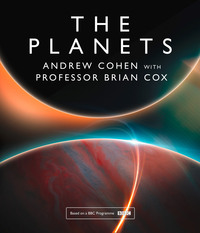
The Planets
The story of our Solar System is not as we once thought it – eternal and unchanging. Instead it is a place of endless transformation. It is a narrative that repeats itself with a predictable rhythm, and as one world passes, another comes into the light. Only one planet has maintained stability for almost the entire life of the Solar System: the Earth has remained habitable for at least 4 billion years while change has played out all around it. What makes the Earth so lucky compared to all of its terrestrial siblings? To answer that question we need to look not just at our planet but at the whole of the Solar System, going right back to the very beginning.
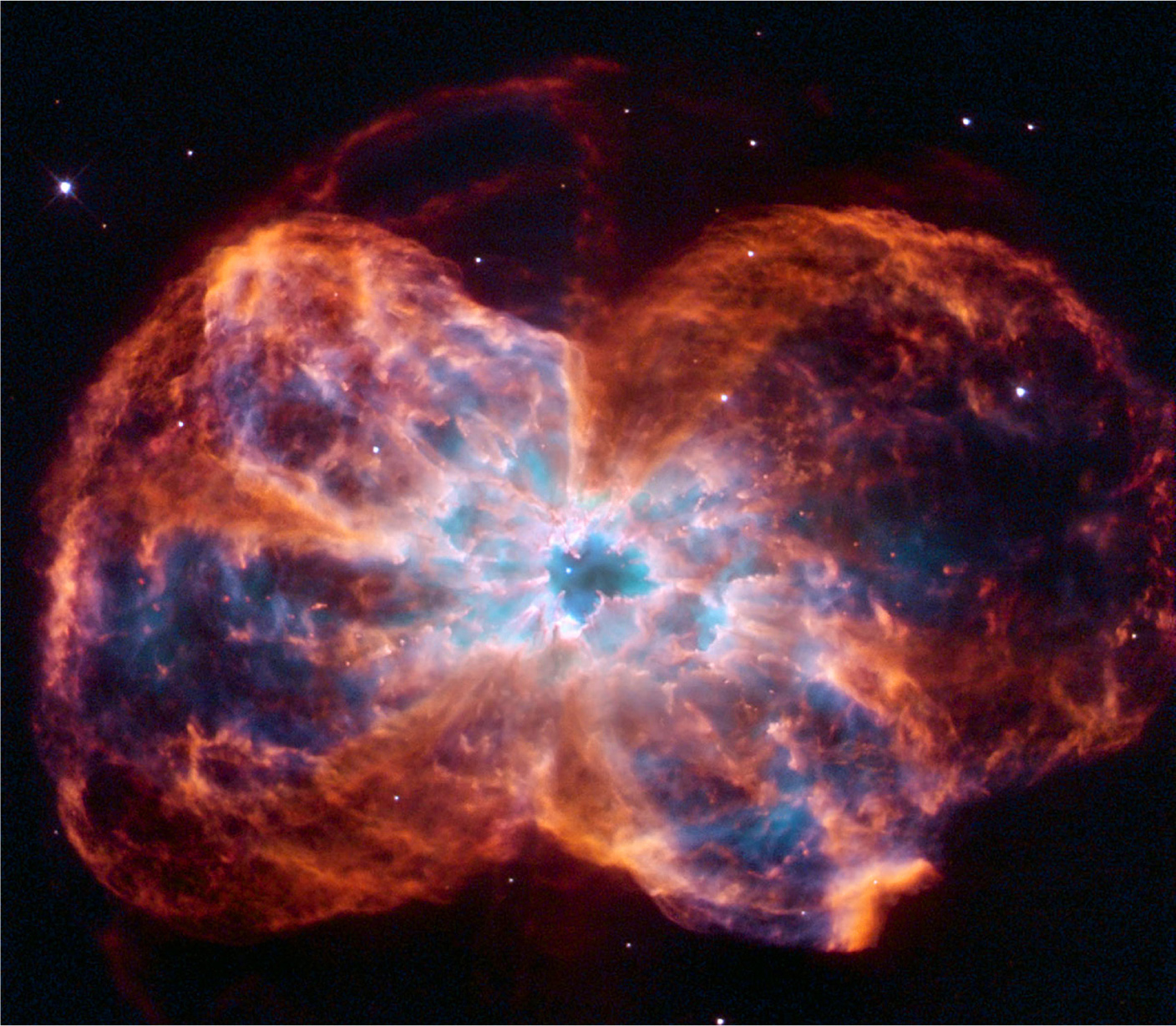
© NASA, ESA, and K. Noll (STScI)
The last colourful hurrah of a star. Ultraviolet light from the dying star causes a glow around the white dwarf at the centre, where the star has burned out. This planetary nebula tells the story of the demise of our own Sun.
IN THE BEGINNING
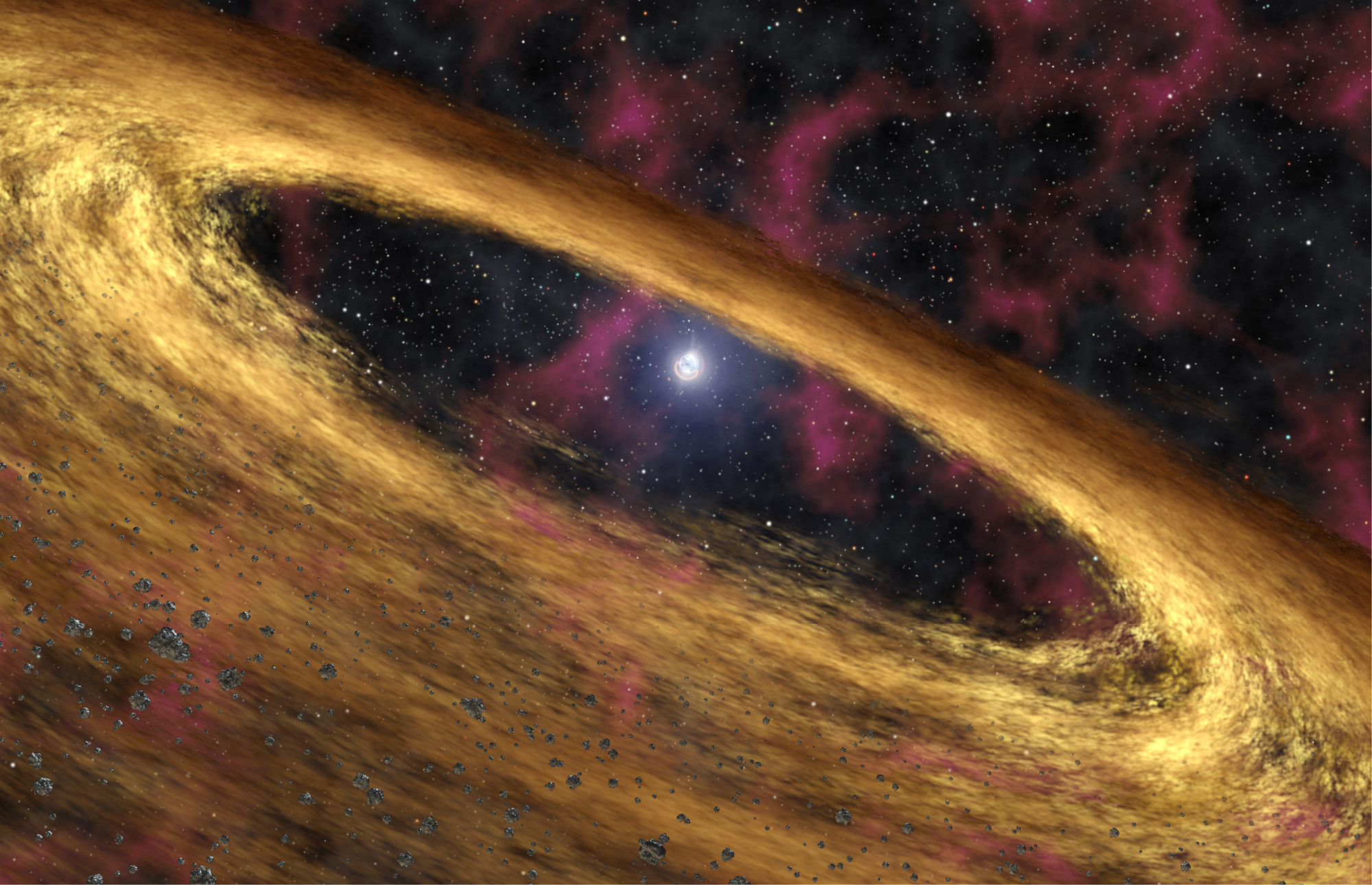
© NASA/JPL-Caltech
This artist’s image represents a dead star known as a pulsar. The disc of rubble that surrounds it resembles the protoplanetary discs of gas and dust that are found around young stars, which collide and coalesce under the gravitational force of attraction to create young planets.
For the first few million years after its birth, there were no terrestrial worlds to see the Sun rise, and there were no days, no nights, no circular tracks around it. Instead, surrounding our infant star was a vast cloud of dust and gas. A tiny fraction of the material left over from the Sun’s formation, this swirling cloud would one day coalesce to form the various planets of the Solar System, and many other smaller bodies, but at this time, 4.7 billion years ago, there was nothing but tiny specks of dust reflecting back the light of our slowly growing star.
Only time – vast amounts of empty time – would allow enough of this gas and dust to catch and cluster, randomly forming the smallest of seeds. Most of these seeds would hardly get the chance to grow at all, smashed apart and returned to the immense swirl of dust from whence they arose. Just a few would grow big enough and survive long enough to capture and condense more of the cloud, slowly increasing their mass and density.
We still do not fully understand the process by which grains of dust no thicker than a human hair can amass to become rocky objects the size of a car, and as yet no model exists to explain this part of the evolution of a planet. But what we do know is that once that disc of gas and dust becomes populated with clumps of rock that make it past the ‘metre-size barrier’, a powerful force comes into play to propel the process forward. These newly formed planetesimals are big enough to allow the great sculpting force of gravity to draw the clumps together, growing to sizes of over a kilometre in length. Swirling around the Sun, thousands upon thousands of these objects live and die, colliding and coalescing under the increasing gravitational forces of attraction until eventually just a few emerge as planetary embryos, moon-sized bodies known as protoplanets. In the last violent steps of the process of planetary birth these protoplanets swirl around in crowded orbits, and many are destroyed, returned to the dust of their origins, but occasionally when a collision brings two or more of these giant objects together, the size of this mass of rock becomes big enough for gravity to pull it in from all sides, creating a sphere of newly formed rock, a new world. In that moment a planet is born.
Each of the terrestrial planets in our Solar System was born this way. They are the survivors of a process that destroys far more worlds than it ever creates, and which left just four rocky planets remaining – starting closest to the Sun with Mercury, then Venus, Earth and finally, farthest out, the cold and dead world of Mars. Today these four worlds all look vastly different, and yet all were created the same way, made up of the same ingredients and orbiting the same star. So why have they ended up so distinct from each other, and with such starkly different environments? And what makes this place, the Earth, so unique, the only one of the rocks that has blossomed with life? To understand, we have to look deep into the past of our Solar System, to explore the unique history of each of the planets by means of amazing feats of human engineering across billions of miles, and into environments of unknown and unimaginable extremes.
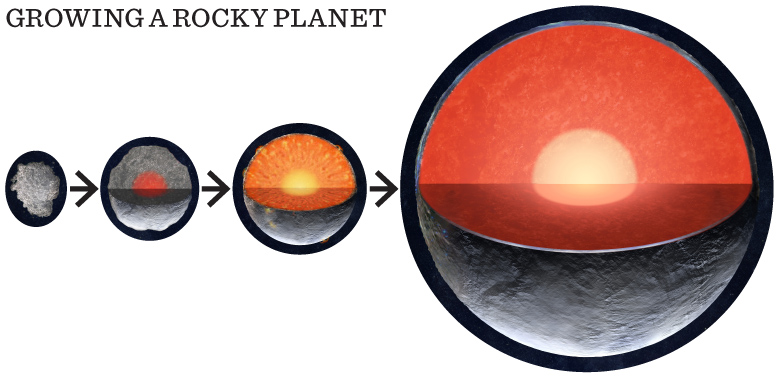
© NASA/JPL-Caltech
EXPLORING MERCURY
Getting to the smallest planet in the Solar System is anything but easy. Skirting past the Sun at a distance of just 46 million kilometres at the closest point in its orbit, Mercury is a planet that is not only held deep in the gravitational grip of our massive star but is also moving at an average orbital speed of 48 kilometres per second (km/s), by far the fastest-orbiting planet in the Solar System and far outpacing the Earth’s more leisurely 30 km/s. It needs to whip around this quickly, otherwise it would have fallen into the Sun’s embrace long ago, but the combination of its speed and position make it a planet that’s immensely difficult to get close to, and even harder to get into orbit around. In order to do so, you have to travel fast enough to catch up with Mercury but not so fast that you cannot somehow slow down to prevent a headlong descent into the Sun, and that challenge has meant that until relatively recently it was the least explored of all the terrestrial planets.
For many decades our first and only close-up glimpse of the innermost rock orbiting the Sun came from the Mariner 10 spacecraft, when on three separate occasions in 1974 and 1975 it briefly flew past Mercury. This was the first spacecraft to use another planet to slingshot itself into a different flightpath, using a flyby of Venus to bend its trajectory to allow it to enter an orbit that would bring it near enough to Mercury to photograph it close up. Clad in protection to ensure it could survive the intense solar radiation and immense extremes of temperature, Mariner 10 was able to send back the first detailed images of Mercury as it flew past at just over 200 miles above its surface. It passed by the same sunlit side of Mercury each time, so it was only able to map 40 to 45 per cent of Mercury’s surface.
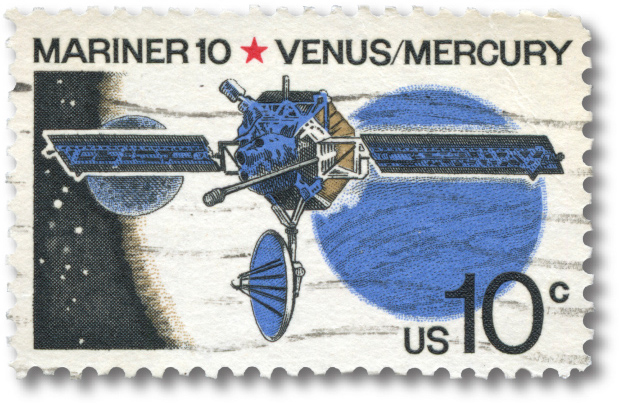
© Shutterstock

© NASA/Johns Hopkins University Applied Physics Laboratory/Carnegie Institution of Washington
The first glimpse of Mercury from Messsenger, nearly 40 years after Mariner 10’s historic mission.
The spacecraft took over 2,800 photos, which gave us never-before-seen views of the planet’s cratered, Moon-like surface, a surface that we had never previously been able to fully resolve through Earth-based observation. Despite the beauty of the pictures taken, it wasn’t the images from Mariner 10 that really surprised us, it was the data the probe collected relating to Mercury’s geology, which pointed to a much more surprising history of the planet than had previously been imagined. Mercury, it seemed, was far from being just a scorched husk.
Mariner was able to sense the remains of an atmosphere consisting primarily of helium, as well as a magnetic field and a large iron-rich core, opening a mystery that would remain unexplored for another 30 years. As it flew past Mercury for the last time on 16 March 1975, the transmitters were switched off and its contact with Earth silenced. Mission completed, Mariner 10 began a lonely orbit of the Sun that, as far as we know, continues to this day.
‘We have Mercury in our sights.’
MDIS Instrument team, 10.30 am EST, 9 January 2008.
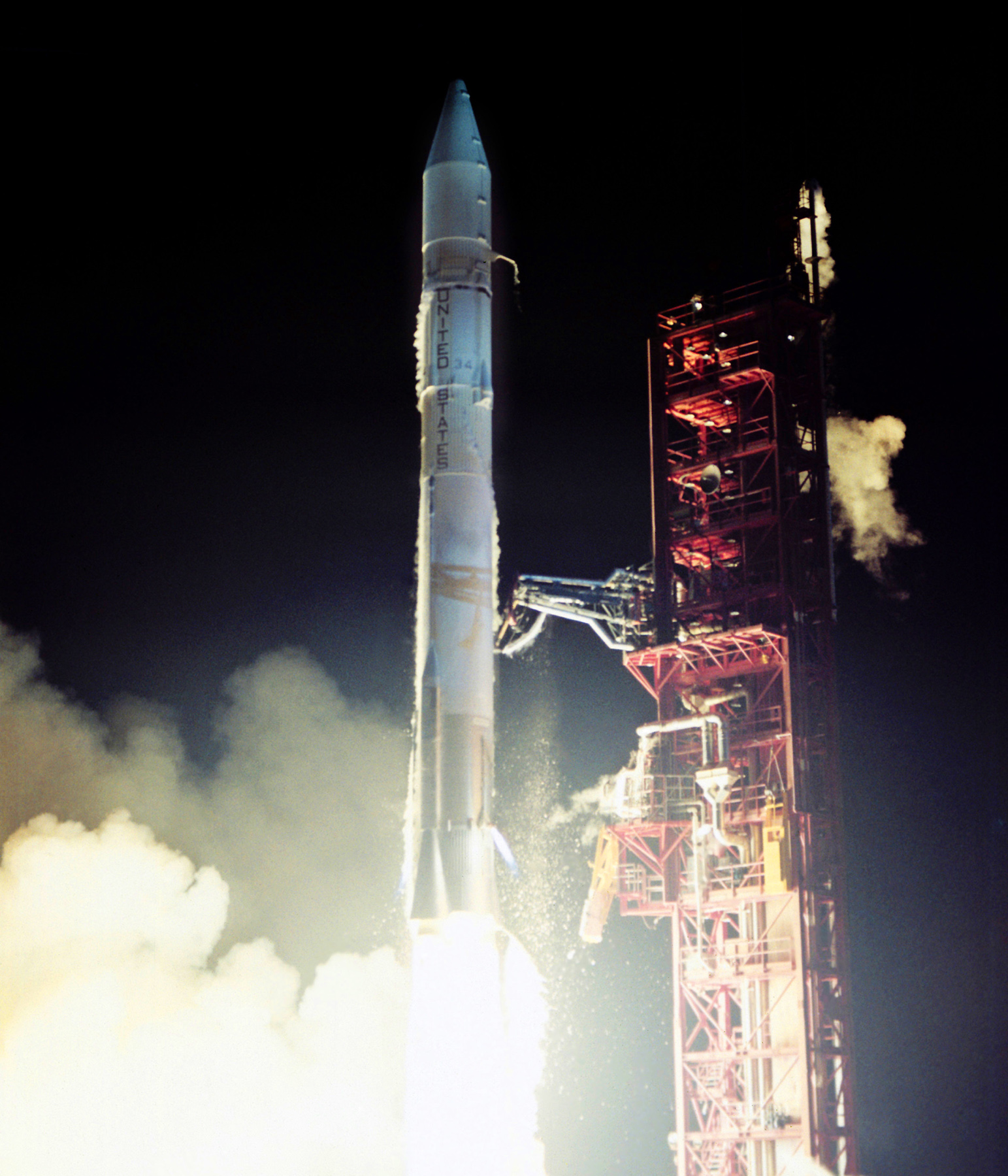
© NASA / SCIENCE PHOTO LIBRARY
Mariner 10, launched on 4 November 1973 from Cape Canaveral, was the first unmanned spacecraft to fly past Mercury, managing to map half of the planet’s surface in the process through over 2,800 photos, and giving us a unique insight into its history and makeup.
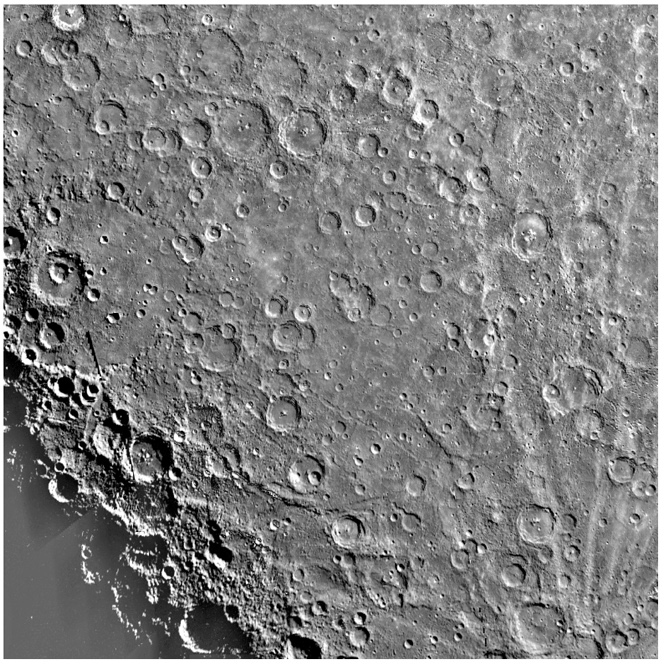
© NASA/JPL
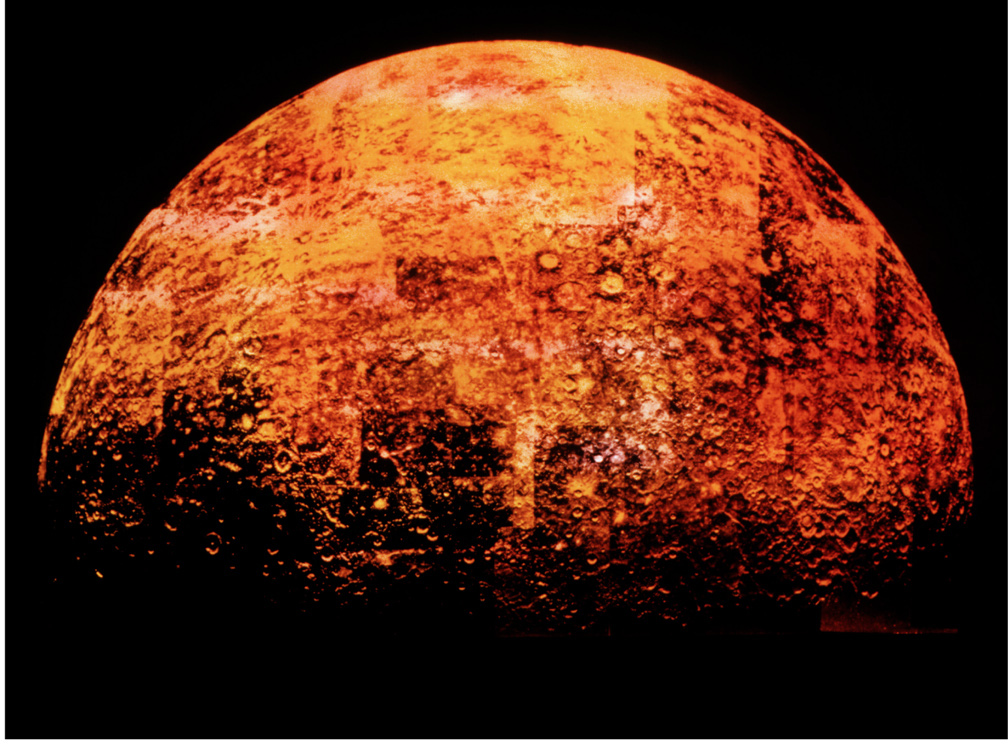
© NASA, COLOURED BY MEHAU KULYK / SCIENCE PHOTO LIBRARY
These images, both in their original glory and false-coloured, clearly show some of the thousands upon thousands of impact craters that make up the surface of Mercury.
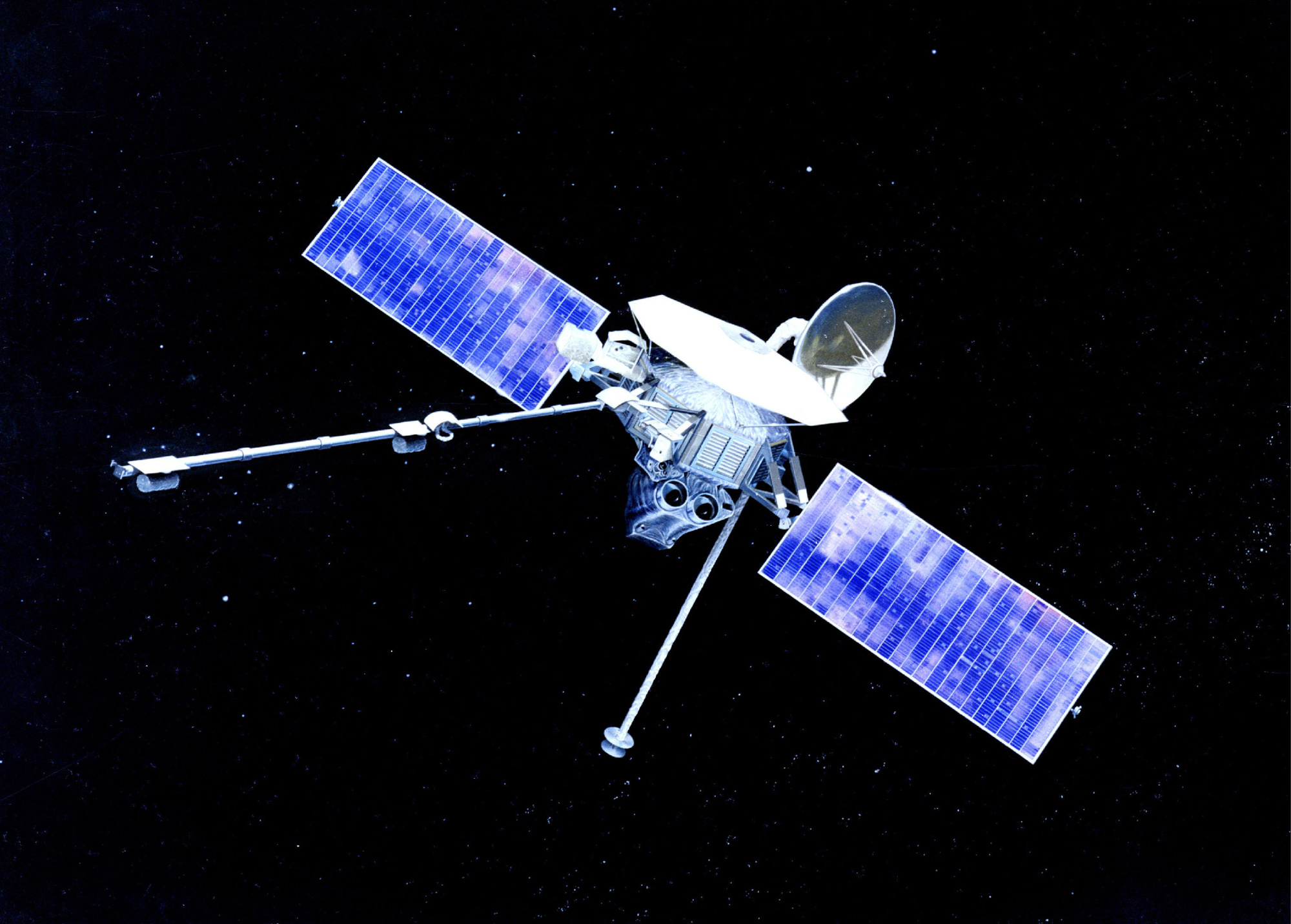
© NASA Wikimedia Commons
This model of Mariner 10 shows the spacecraft in flight. In a highly complex mission, the craft used the gravitational pull of a planet to direct it and large solar panels acted as sails whenever scientists needed to correct Mariner’s course.
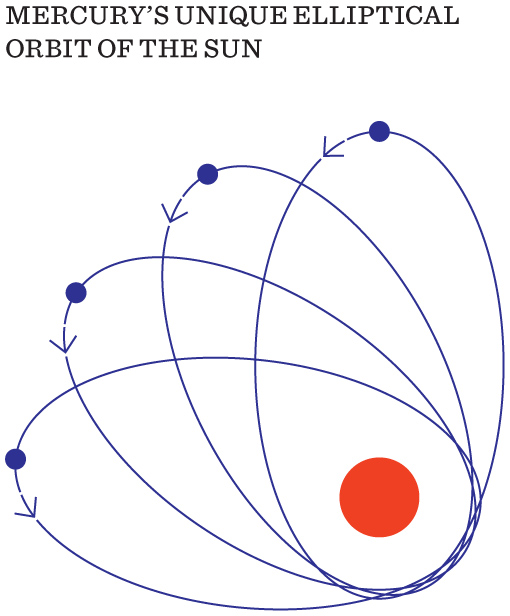
© NASA/Johns Hopkins University Applied Physics Laboratory/Carnegie Institution of Washington
Mercury’s elliptical path around the Sun shifts slightly with each orbit, such that its closest point to the Sun moves forward with each pass. This discovery could not be verified with Newtonian physics and it took Albert Einstein’s theory of relativity to finally explain it.
At first sight many things about Mercury simply don’t make sense. During its 88-day orbit around the Sun it travels in a lopsided, elliptical orbit, which means it can be as far away from the Sun as 70 million kilometres but occasionally as close as 46 million kilometres. This is by far the most irregular of orbits of all the planets, but it is not the end of Mercury’s oddity. Temperatures at midday can rise to 430 degrees Celsius on the surface, but at night, because it’s a small planet and it has no atmosphere, temperatures fall to minus 170 degrees, giving it the greatest temperature swing of any known body in the Solar System. Its rotation is also unusual, gravitationally locked to the Sun in what is known as a 3:2 spin orbital resonance. This means the planet spins precisely three times on its axis for every two orbits, which in turn means that its day is twice as long as its year. In effect, you could be travelling over its surface at walking pace and keep the Sun at the same point in the sky as you strolled through eternal twilight.
As planetary scientist Nancy Chabot explains, ‘A day on Mercury is not like a day on Earth. It has a very unusual orbit … It has to go around the Sun twice to have one complete solar day on the planet, where the Sun goes from directly overhead to directly overhead and this actually takes 176 Earth days.’ Because of the planet’s orbit, there are places on the Mercurian surface where a hypothetical observer would be able to see the (two and a half times larger in the sky) Sun appear to rise and set twice during one Mercurian day. It rises, then arcs across the sky, stops, moves back towards the rising horizon, stops again, and finally restarts its journey towards the setting horizon.
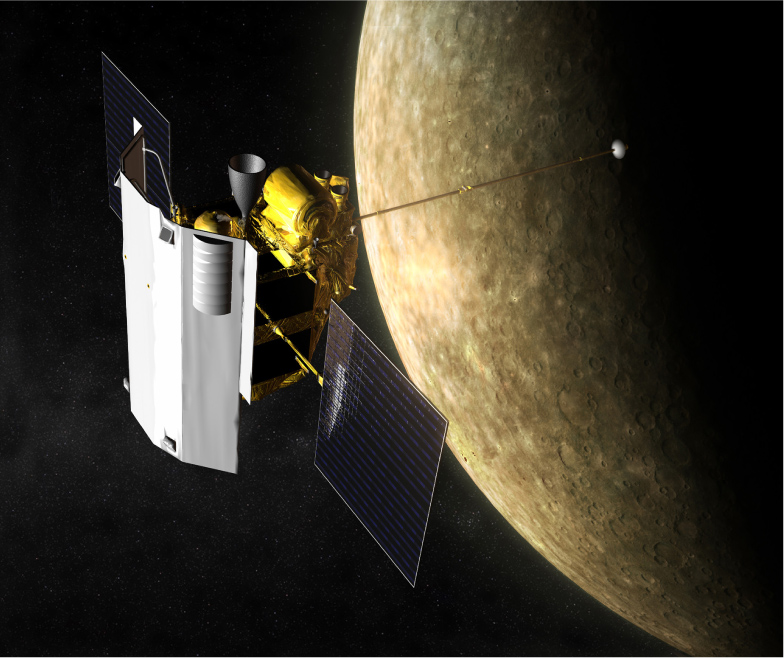
© HarperCollins
At the end of a long, circuitous route, Messenger finally enters Mercury’s orbit on 18 March 2011, the first spacecraft to do so.
‘With the beginning today of the primary science phase of the mission, we will be making nearly continuous observations that will allow us to gain the first global perspective on the innermost planet.’
Sean Solomon, Messenger mission
Most of Mercury’s anomalies can be explained by the orbital mechanics of its journey around the Sun, except, that is, for the odd elliptical orbit that takes it on such an oval-shaped, elongated course. This irregularity has puzzled astronomers for centuries and hints at an ancient planet that was very different from the Mercury we see today.
5 … 4 … 3 Main engines start 2 … 1 … and zero and lift off of Messenger on NASA mission to Mercury … a planetary enigma in our inner solar system
To truly begin to understand Mercury’s history we had to wait nearly 40 years before we could return to her. On 18 March 2011, NASA’s Messenger spacecraft became the first to enter Mercury’s orbit, and over the next four years it succeeded in not only photographing 100 per cent of the planet’s surface, but also collecting extensive data on its geology.
But before any of this could happen, Messenger had to take perhaps the most circuitous route in the history of our exploration of the Solar System. Just passing close to Mercury to take a few snaps, as Mariner 10 did, is hard enough, but actually entering into its orbit was thought to be either too difficult to achieve or too costly to execute. As cosmochemist on the Messenger mission Larry Nittler explained, ‘There are two major challenges to getting a spacecraft into orbit around Mercury: gravity and money. When you go from Earth to Mercury, you’re falling into the gravitational well of the Sun, which makes you accelerate faster and faster as you get closer. And, if you were to go straight from Earth to Mercury, this means that you would basically just zip right by the planet, or you would need to bring an incredible amount of fuel to put the brakes on, more than you could actually afford.’
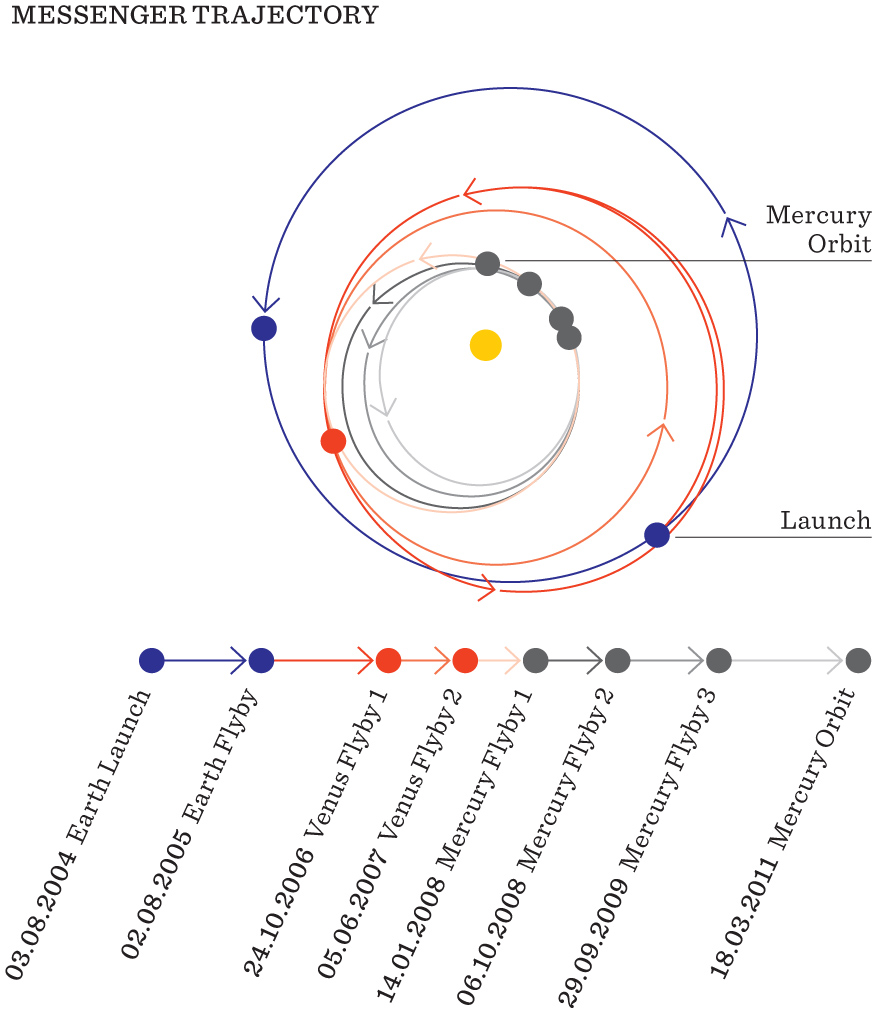
© HarperCollins
Messenger’s six-year, seven-month, 16-day journey to Mercury took it on a complex route involving several gravity assist manoeuvres before it entered the planet’s orbit.
A number of missions never made it further than pencil and paper, while others floundered and failed at the proposal stage. It was only when Chen-wan Yen, a NASA engineer from the Jet Propulsion Laboratory (JPL), provided a trajectory that could not only get a craft into orbit but could do it at an estimated bargain-bucket cost of 280 million dollars, that the Messenger mission could really begin to take flight.
Taking off from Cape Canaveral on 3 August 2004, Messenger began a six-year, seven-month, 16-day journey to Mercury that would take it on a 7.9-billion-kilometre trajectory before it entered into orbit around the smallest of all the planets. To arrive at Mercury with the right speed and on the right course would require a complex route that would entail a number of gravity-assist manoeuvres around the Earth, Venus and Mercury itself to reduce the speed of the craft relative to Mercury. So, combined with the brief firing of its large rocket engine to finally insert it into orbit, this mission profile allowed Messenger to complete its voyage without the need to carry the vast reserves of fuel required to slow its passage through the firing of rockets. This design made the craft lighter and cheaper, but ultimately much slower. Almost seven years was a long time to wait for the team patiently charting its progress across the stars. Larry Nittler described Messenger’s course as ‘sneaking up on [Mercury] by taking a seven-year journey, flying around the Sun many times, doing multiple flybys around Mercury and Venus, and each time transferring some of [the] craft’s speed and energy to the planet, so it could slow down, so that when we finally got to Mercury after seven years, we were able to fire our engine just a little bit, to slow down [even more] and get captured by the weak gravitational field of the planet’.
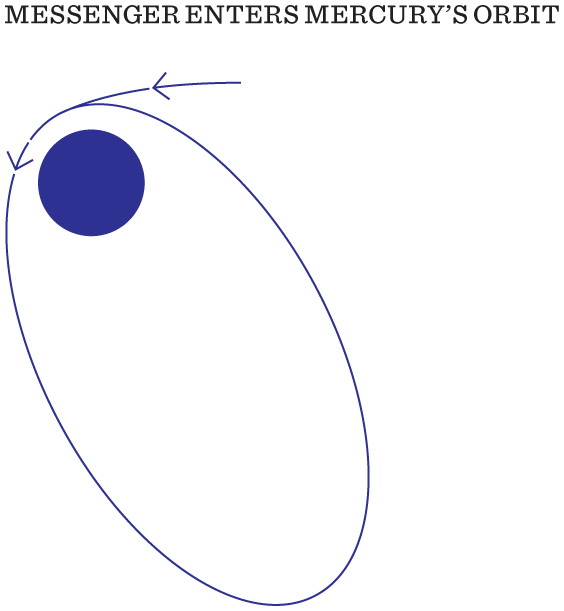
© HarperCollins
The highly elliptical path taken by Messenger to finally enter Mercury’s orbit at 00.45 UTC on 18 March 2011.
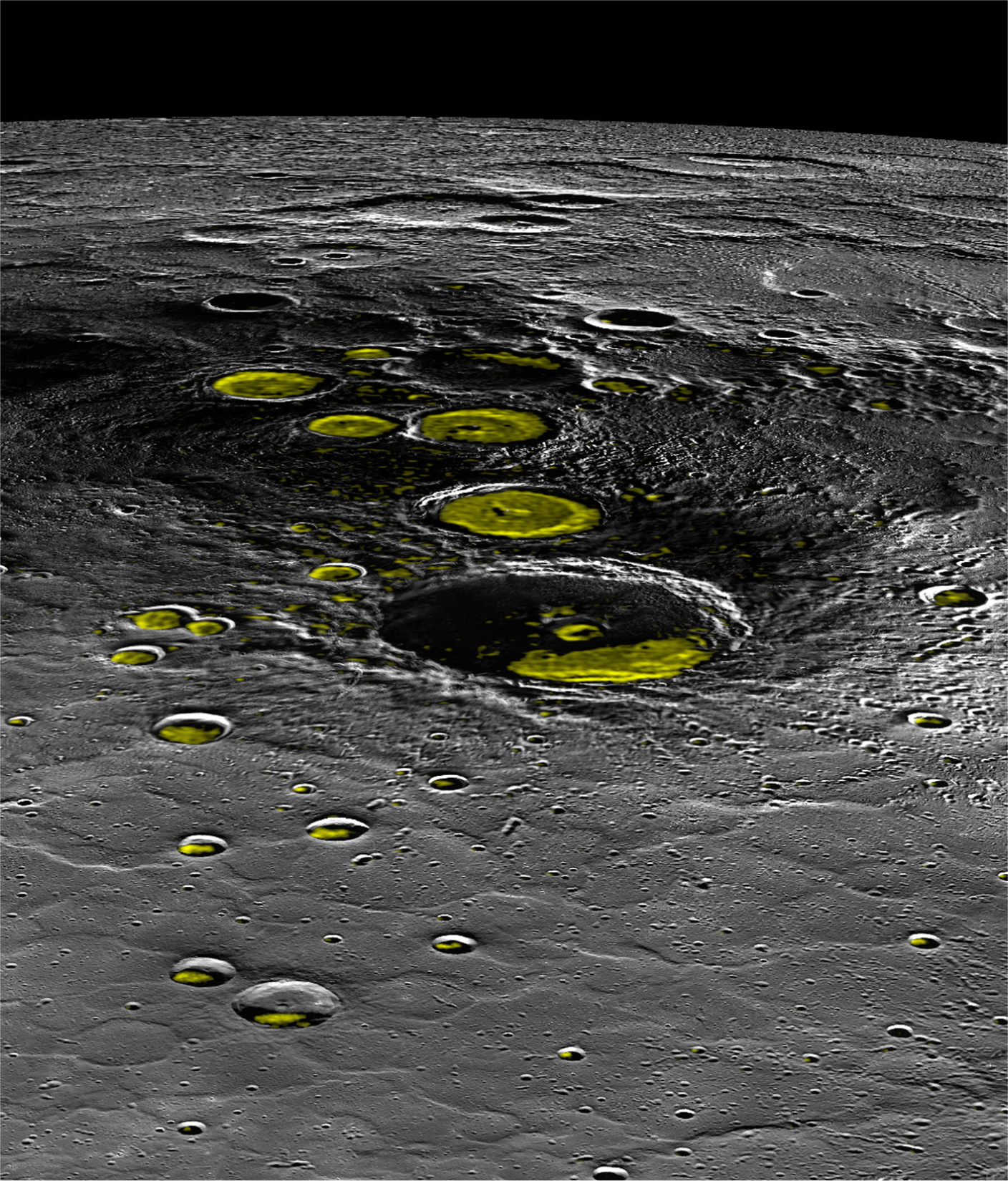
© NASA/Johns Hopkins University Applied Physics Laboratory/Carnegie Institution of Washington
Messenger’s mission was a deeper exploration of the cratered landscape and geology of Mercury. One major discovery from its imaging work was evidence of water ice in its polar craters.
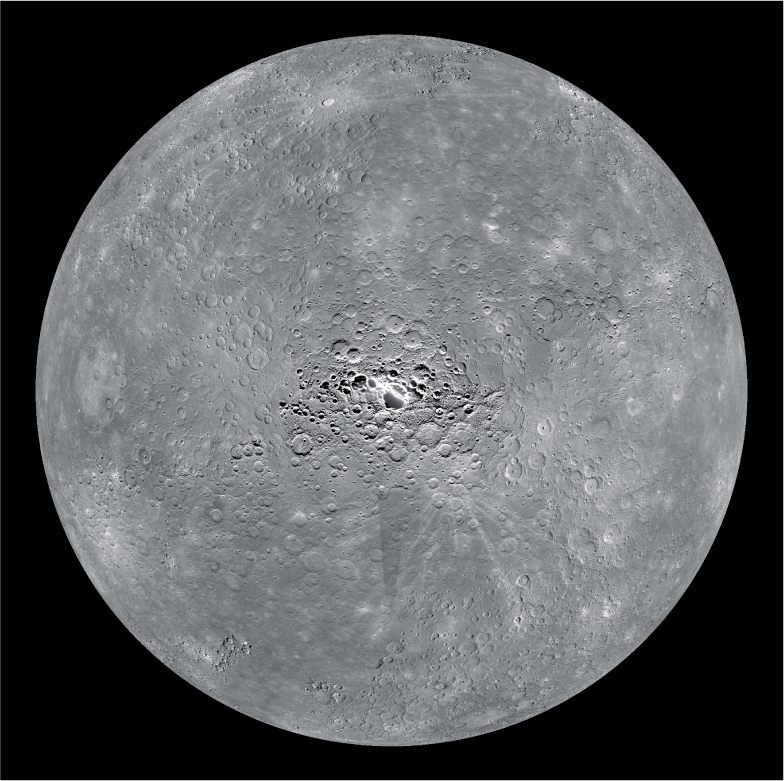
© NASA/Johns Hopkins University Applied Physics Laboratory/Carnegie Institution of Washington
Messenger took images of Mercury’s south pole on several orbits, allowing scientists to monitor the region through changing illumination.
Appropriately, when Messenger finally entered into Mercury’s orbit at 00.45 UTC on 18 March 2011, the path it settled into was highly elliptical. This orbit took it on a 12-hourly cycle from 200 kilometres above the planet’s surface to 10,000 kilometres away from it. It may seem like an odd orbit for a craft with the singular aim of getting as close to Mercury as possible, but this was an essential part of the design of the mission, vital to protect Messenger from the fierce heat radiated by the scorching hot surface of Mercury. The sunlight reflected from the surface is so powerful it would have literally melted the solder holding the spacecraft together if it wasn’t given time to cool down between its closest approaches to the planet.
Protected by an enormous ceramic solar shield and its eccentric orbit, Messenger could begin its work. For two years the spacecraft mapped pretty much every bit of the surface of Mercury, and the images beamed back to Earth revealed a planet that’s been in the firing line for billions of years. Too small to hold on to an atmosphere that might protect it from meteorites, and lacking any processes to recycle old terrain, Mercury’s ancient surface is the most cratered place in the Solar System.
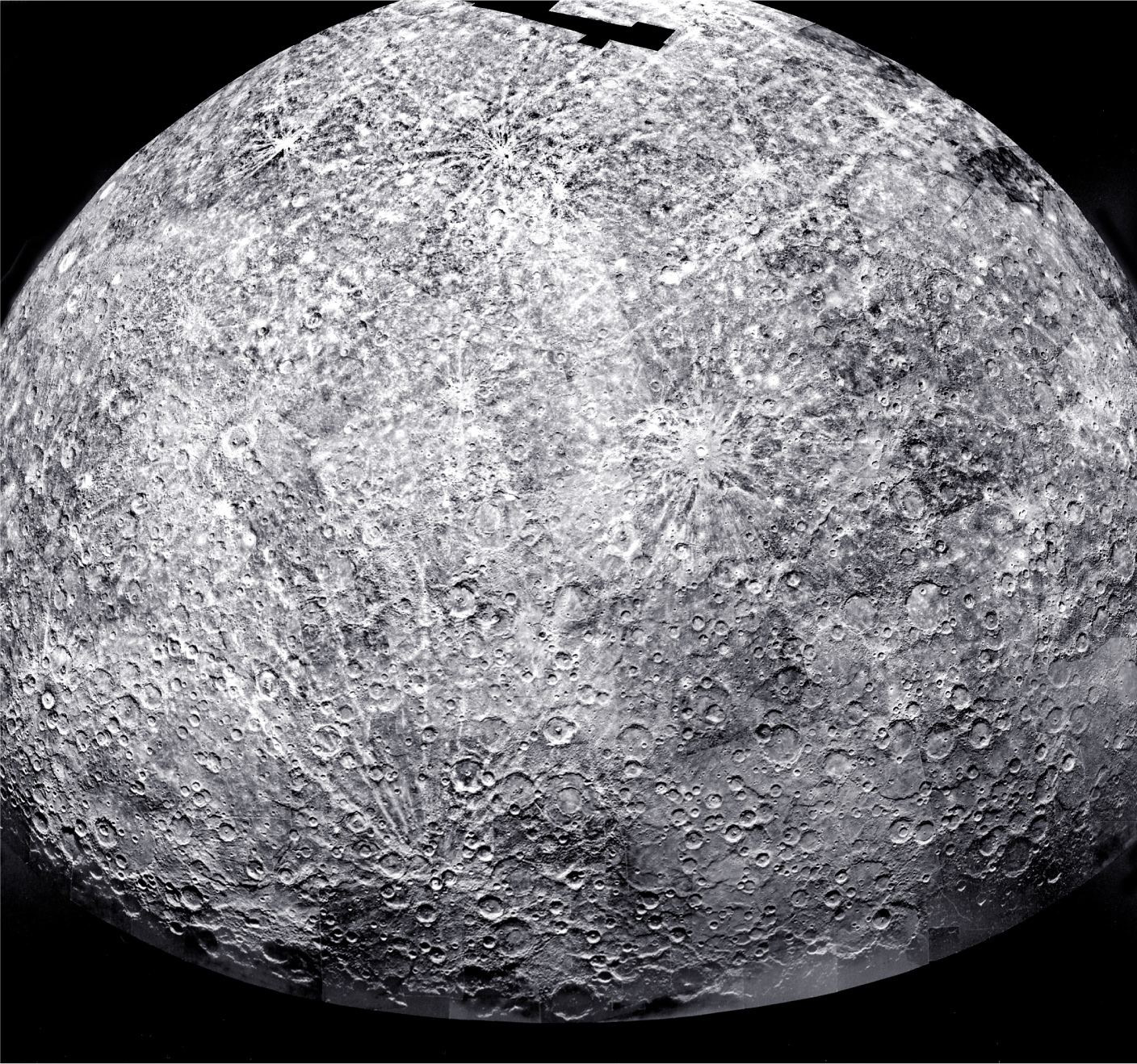
© NASA/JPL
This computer photomosaic of Mercury’s southern hemisphere was created from images taken by Mariner 10 on its flyby of Mercury, giving scientists a tantalising glimpse of this elusive planet.
Cosmochemist Larry Nittler explains the reason behind Messenger’s elliptical orbit
‘The way we addressed the problem of heat from the planet was to be in an extremely elliptical orbit, where we flew in very close over the North Pole, and took observations close to there, but then flew very far over the South Pole, like 10,000 kilometres. And so a couple of times a day we’d zoom in over the North Pole, get our data close, but the instruments would heat up, so then we’d fly and get different data farther out from the planet while we cooled, and in this way – heat up, cool down – we kept everything below the danger temperatures where instruments could be damaged.’
MAPPING MERCURY
The Mariner 10 mission had enabled scientists to see about half of the planet, so the first full view of the terrain of Mercury came from the flybys of Messenger. As planetary scientist Nancy Chabot explains, ‘Before Messenger, we had only seen 45 per cent of the planet and we saw some stuff during the flybys before we went into orbit, but after orbiting the planet we have now mapped 100 per cent of the planet and seen nearly everywhere. There are some permanently shadowed regions which are still mysterious … but after mapping the full planet, we have a good idea of what the surface looks like and craters are absolutely a dominant land form. This planet has been sitting there for billions of years and been hit over and over, and it hasn’t had a lot of processes to destroy those craters.’
‘Scars are just another kind of memory.’
M.L. Stedman
Amongst the thousands upon thousands of craters on Mercury, the largest by far is Caloris Planitia, a lowland basin 1,525 kilometres in diameter that is thought to have formed in the early years of the Solar System, around 3.9 billion years ago. It was first spotted as Mariner 10 sped past in 1974, but due to the trajectory and timing of the craft only half of it was lit, so the full character of this crater remained a mystery for another 30 years until Messenger could photograph it in all of its glory. Taking one of its very first photos, Messenger revealed Caloris to be bigger than had been previously estimated, encircled by a range of mountains rising 2 kilometres from the Mercurian surface, whose peaks create a 1,000-kilometre boundary around the lava plains within.
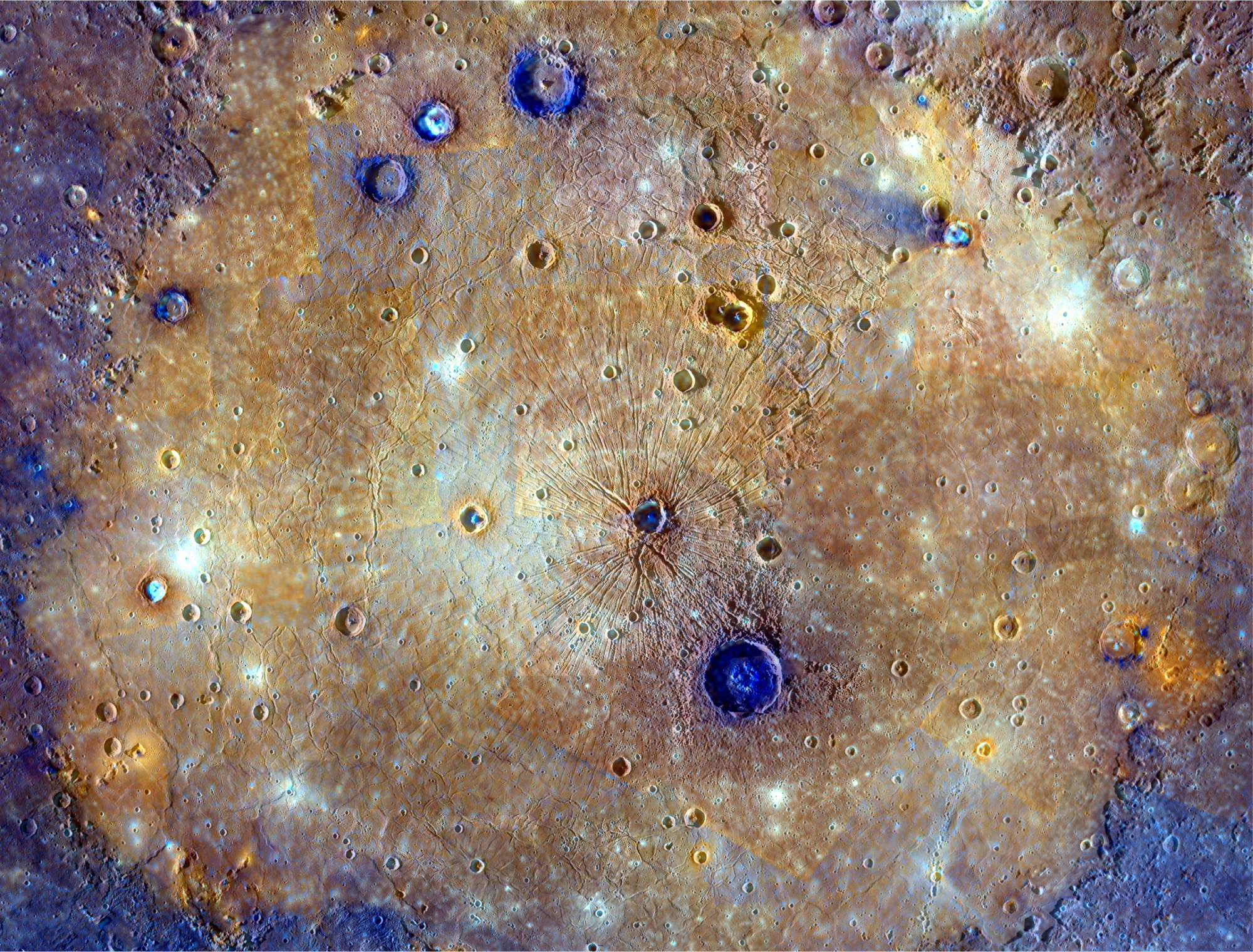
© NASA/Johns Hopkins University Applied Physics Laboratory/Carnegie Institution of Washington
This colour mosaic of Mercury’s Caloris basin was created using images taken by Messenger in 2014.
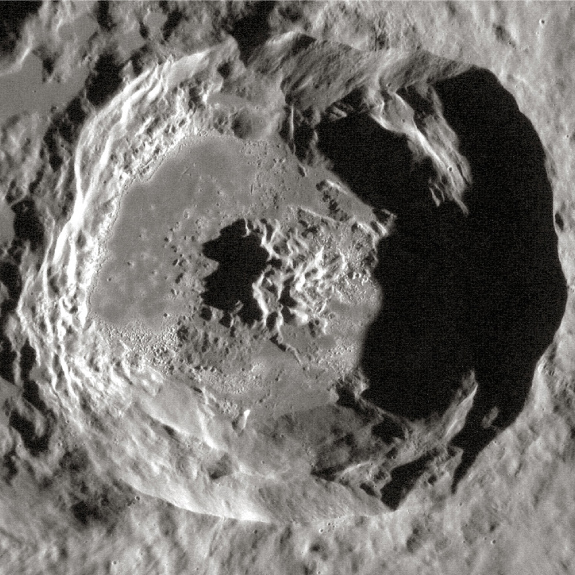
© NASA/Johns Hopkins University Applied Physics Laboratory/Carnegie Institution of Washington
Messenger photographed Mercury’s geology in great detail, capturing this crater within the vast Caloris basin.
On the other side of the mountains, the vast amount of material that was lifted from the planet’s surface at the moment of impact formed a series of concentric rings around the basin, stretching over 1,000 kilometres from its edge. The collision that created Caloris hit Mercury with such force that it also had more global consequences. Messenger photographed in great detail an area named (in the not particularly scientific vernacular) ‘the weird terrain’, a region at the planet’s diametrically opposite point, the antipode, to Caloris. This area of strange geological formations distinct from the rest of the surrounding terrain was likely created by the seismic shockwave of the Caloris impact reverberating through the whole of the planet.
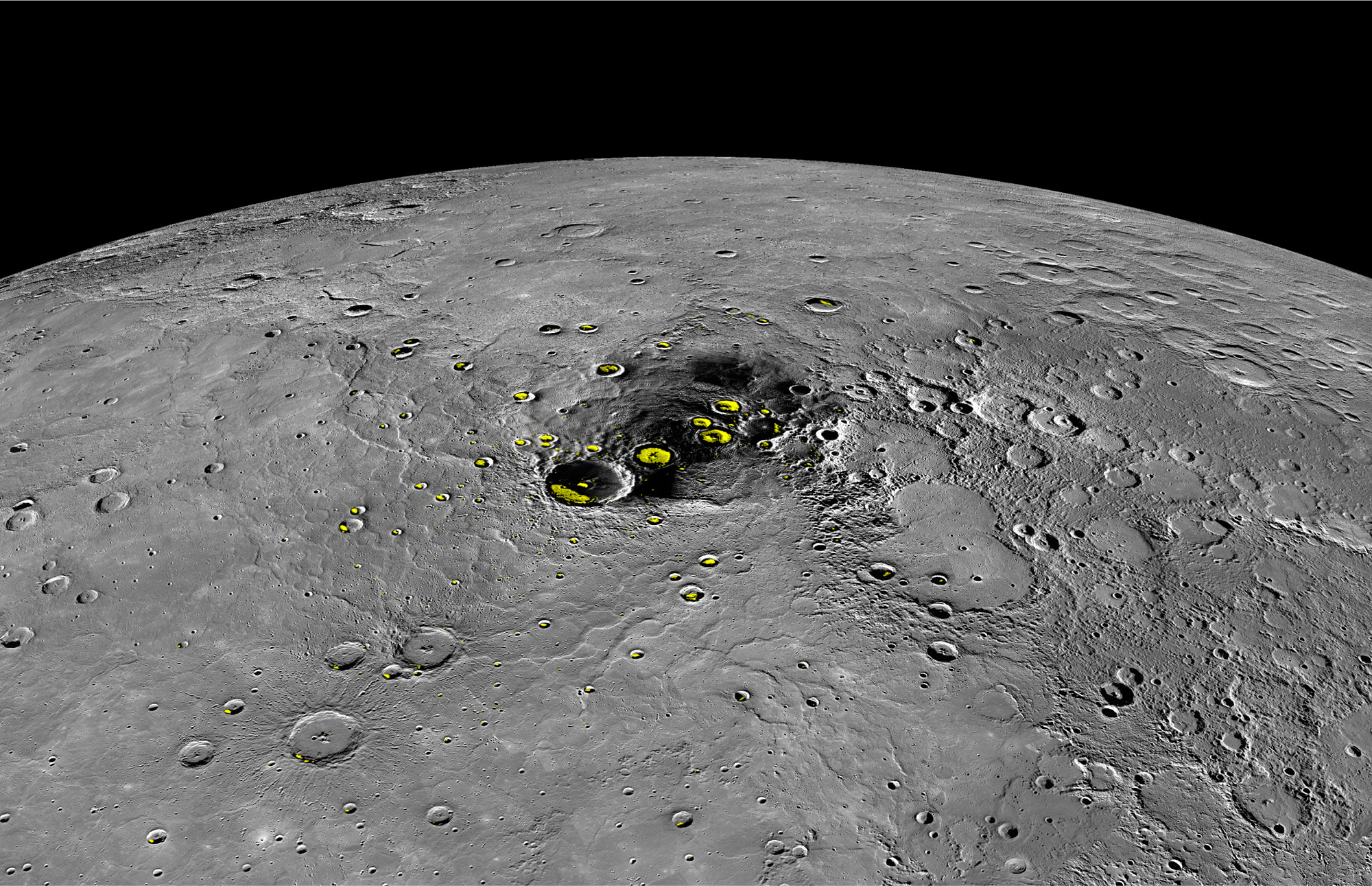
© NASA/Johns Hopkins University Applied Physics Laboratory/Carnegie Institution of Washington
In this 3D view of Mercury’s north polar region, the areas marked in yellow show evidence of water ice.
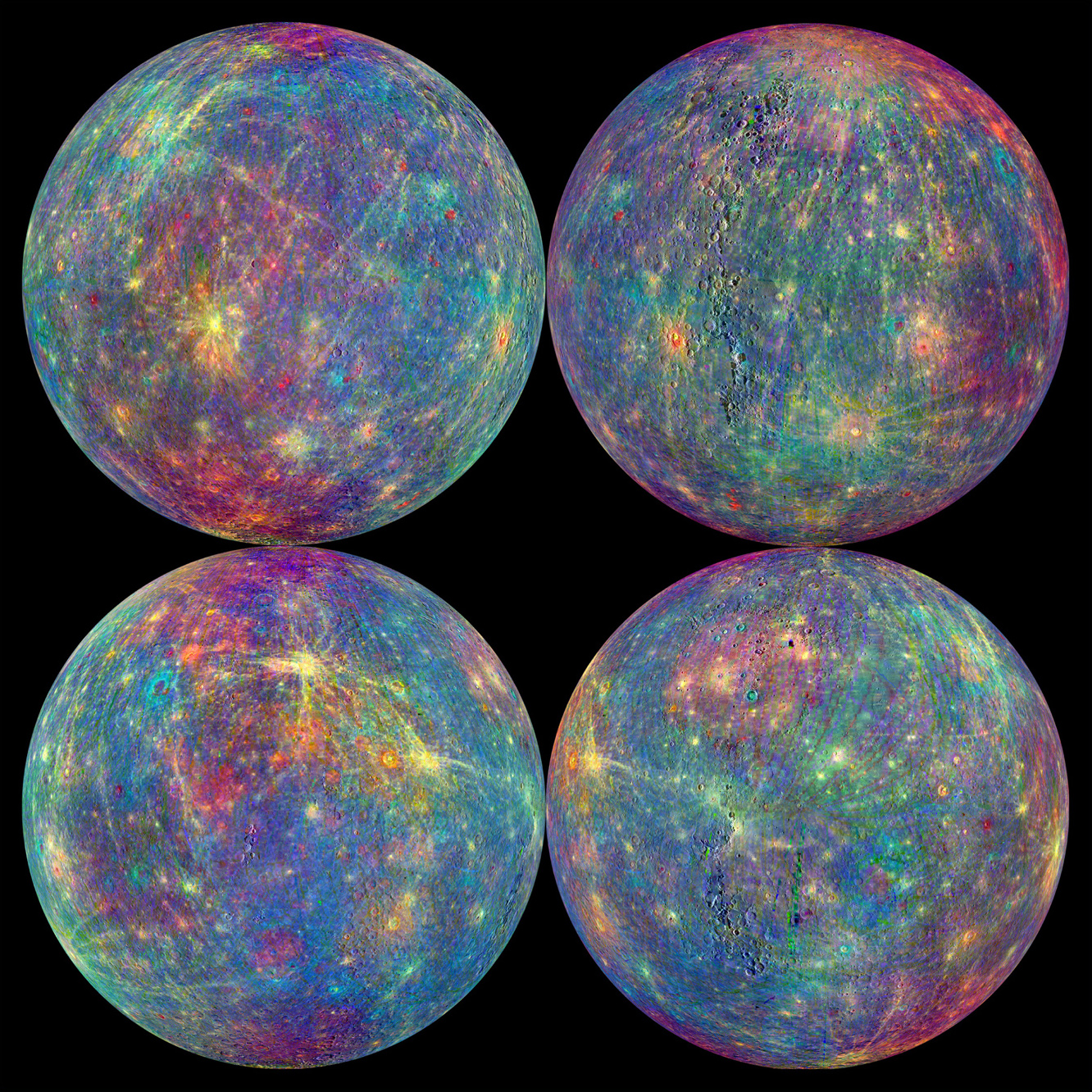
© NASA/Johns Hopkins University Applied Physics Laboratory/Carnegie Institution of Washington
The Mercury Atmosphere and Surface Composition Spectrometer (MASCS) instrument and the Mercury Dual Imaging System (MDIS) aboard Messenger enabled scientists to create these images, which use colours to map out the mineral, chemical and physical makeup of Mercury.
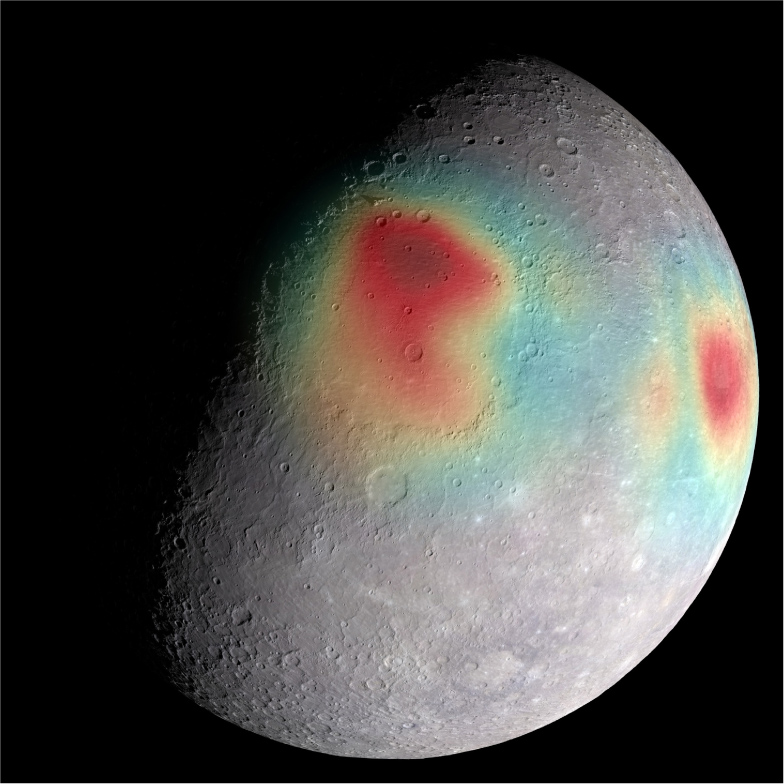
© NASA/Goddard Space Flight Center Science Visualization Studio/Johns Hopkins University Applied Physics Laboratory/Carnegie Institution of Washington
Radio tracking data sent by Messenger has enabled scientists to create maps of the gravity field of Mercury. In this image, Mercury’s gravity anomalies are depicted in colours: red indicates mass concentrations around the Caloris basin (centre) and the Sobkou region (right).

